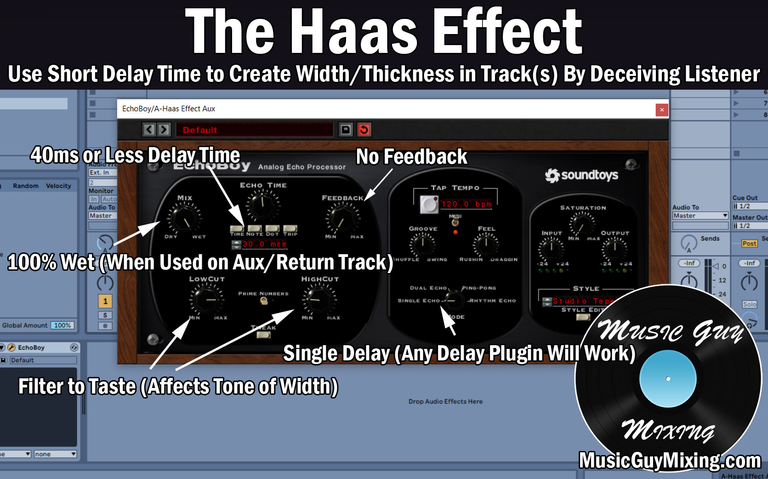
First, we need to be clear about some concepts such as acoustics, psychoacoustics and the basic knowledge of the hearing process.
The so-called Haas curve indicates the intensity (expressed in dB) required to achieve an equivalence in terms of delay in milliseconds between two signals. This Haas curve is used in acoustics, among other things, to maintain stereo in rooms.
Psychoacoustics:
Acoustics is "an interdisciplinary science that deals with the study of all mechanical waves in liquid and solid gases, including vibrations, sound, ultrasound and infrasound." It is divided into multiple branches and one of them is psychoacoustics, which is the scientific study of sound perception, this means the psychological and physiological responses associated with sound.
As you may know, sound is a form of energy that moves through a medium in pressure waves, and the ear is a sensory organ that recognizes pressure waves and converts them into nerve impulses, since it is the brain and the central nervous system that “listens.”
Sound waves are perceived by the brain through the activation of nerve cells in the auditory portion of the central nervous system. The ear transforms sound pressure waves from the outside world into signals in the form of nerve impulses that are sent to the brain, which is why the brain plays an important role in the whole process. To summarize, the ear can be seen as a transducer with a spectrum analyzer that allows the perception of variations in frequency and energy.
Psychoacoustics and the Haas Effect2. Haas effect:
This psychoacoustic phenomenon describes how the human ear perceives a sound source, identifying the direction of the reflected sound given the time it takes to reach the ear. This effect was studied by Helmut Haas at the University of Gottingen, Gottingen, Germany. A simple experiment to understand the phenomenon is to listen to two identical signals using stereo headphones, where one of the signals is slightly delayed with respect to the other.
The stages of the experiment are illustrated below:
Note: The ear is most sensitive at 1 KHz, so the experiment is performed at that frequency. To understand this, read about the hearing threshold.
• Applying a tone signal to both speakers as seen in figure 1: in this case the sound is perceived as a source in the direction of the bisector angle created between both speakers (in the case of headphones, the source is felt in front).
• By applying a tone signal to both speakers, delaying the signal in one of them by 5 to 30 milliseconds with respect to the other as shown in Figure 2: in this case only one source with double the intensity is perceived in the direction of the non-delayed speaker (in the case of headphones, the source is felt to one side). This same effect can be generated by varying the intensity of the signal in each of the speakers, this is known as panning.
• Applying a tone signal to both speakers, delaying the signal in one of them by more than 35 milliseconds with respect to the other as seen in Figure 3: in this case the delayed sound is perceived as an echo of the first but from different sources (in the case of hearing aids, two different sources are felt on each side).
Tone applied to stereo speakers with delay greater than 35ms
In this way, the phenomenon characterizes the delay experienced in acoustic spaces and gives an idea of how the sound energy of the ear sums up.

Primero hay que ser claros sobre algunos conceptos como acústica, psicoacústica y el conocimiento básico del proceso de audición.
La llamada curva de Haas indica la intensidad (expresada en dB) necesaria para lograr una equivalencia en cuanto al retardo en milisegundos entre dos señales. Esta curva de Haas se utiliza en acústica, entre otras cosas, para mantener el estéreo en recintos.
Psicoacustica:
Acústica es “una ciencia interdisciplinaria que trata el estudio de todas las ondas mecánicas en gases líquidos y solidos, incluyendo vibraciones, sonido, ultrasonido e infrasonido”. Esta se divide en múltiples ramas y una de ellas es la psicoacustica que es el estudio científico de la percepción del sonido, esto significa las respuestas psicologicas y fisiológicas asociadas con el sonido.
Como deben saber el sonido es una forma de energía que se mueve a través de un medio en ondas de presión, y el oído es un órgano sensitivo que reconoce las ondas de presión y las convierte en impulsos nerviosos, ya que es el cerebro y el sistema nervioso central el que “escucha”.
Las ondas de sonido son percibidas por el cerebro a través de la activación de las células nerviosas en la porción auditiva del sistema nervioso central. El oído transforma las ondas de presión de sonido del mundo exterior en señales en forma de impulsos nerviosos que son enviados al cerebro, es por esto que el cerebro juega un papel importante en todo el proceso. Para resumir el oído puede ser visto como un transductor con analizador de espectro que permite percibir variaciones de frecuencia y energía.
Psicoacústica y Efecto Haas2. Efecto Haas:
Este fenómeno psicoacústico describe como el oído humano percibe una fuente de sonido, identificando la dirección del sonido reflejado dado el tiempo que toma en llegar al oído. Este efecto lo trabajo Helmut Haas en la universidad de Gottingen, Gottingen, Alemania. Un experimento simple para la comprensión del fenómeno es escuchar dos señales iguales usando auriculares estéreo, donde una de las señales se encuentre ligeramente retardada con respecto a la otra.
Las Etapas del Experimento se ilustran a continuación:
Nota: El oído es más sensible a un 1 KHz por lo que el experimento se realiza a esa frecuencia. Para entender esto consulta sobre el umbral de audición.
• Aplicando una señal de un tono en ambos parlantes como se ve en la figura 1: en este caso el sonido es percibido como una fuente en dirección del Angulo bisector creado entre ambos parlantes (en caso de audífonos, la fuente se siente al frente).
• Aplicando una señal de un tono en ambos parlantes, retardando la señal en uno de ellos entre 5 y 30 milisegundos respecto a la otra como se ve en la Figura 2: en este caso solo se percibe una fuente con el doble de intensidad en la dirección del parlante no retardado (en caso de audífonos, la fuente se siente a un lado). Este mismo efecto puede ser generado variando la intensidad de la señal en cada uno de los parlantes, esto se conoce como paneo.
• Aplicando una señal de un tono en ambos parlantes, retardando la señal en uno de ellos mas de 35 milisegundos respecto a la otra como se ve en la Figura 3: en este caso el sonido retardado es percibido como un eco del primero pero de fuentes diferentes (en caso de audífonos, se sienten dos fuentes diferentes a cada lado).
Tono aplicado a parlantes estero con retardo mayor a 35ms
De esta manera el fenómeno caracteriza el retardo experimentado en espacios acústicos y da una idea de cómo es la suma la energía del sonido del oído.
| Blogs, Sitios Web y Redes Sociales / Blogs, Webs & Social Networks | Plataformas de Contenidos/ Contents Platforms |
|---|---|
| Mi Blog / My Blog | Los Apuntes de Tux |
| Mi Blog / My Blog | El Mundo de Ubuntu |
| Mi Blog / My Blog | Nel Regno di Linux |
| Mi Blog / My Blog | Linuxlandit & The Conqueror Worm |
| Mi Blog / My Blog | Pianeta Ubuntu |
| Mi Blog / My Blog | Re Ubuntu |
| Mi Blog / My Blog | Nel Regno di Ubuntu |
| Red Social Twitter / Twitter Social Network | @hugorep |

| Blurt Official | Blurt.one | BeBlurt | Blurt Buzz |
|---|---|---|---|
 |  |  |  |
 |  |  |  |
|---|

Upvoted. Thank You for sending some of your rewards to @null. Get more BLURT:
@ mariuszkarowski/how-to-get-automatic-upvote-from-my-accounts@ blurtbooster/blurt-booster-introduction-rules-and-guidelines-1699999662965@ nalexadre/blurt-nexus-creating-an-affiliate-account-1700008765859@ kryptodenno - win BLURT POWER delegationNote: This bot will not vote on AI-generated content
Thanks!!